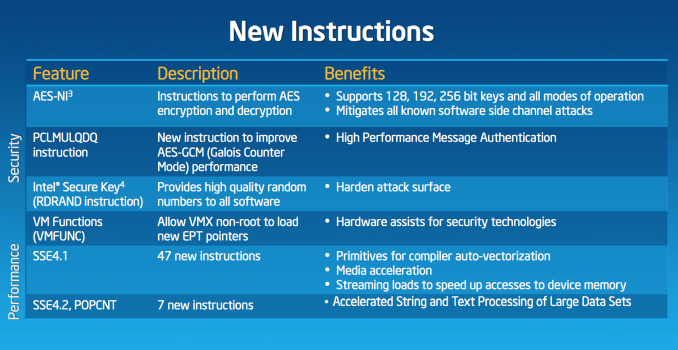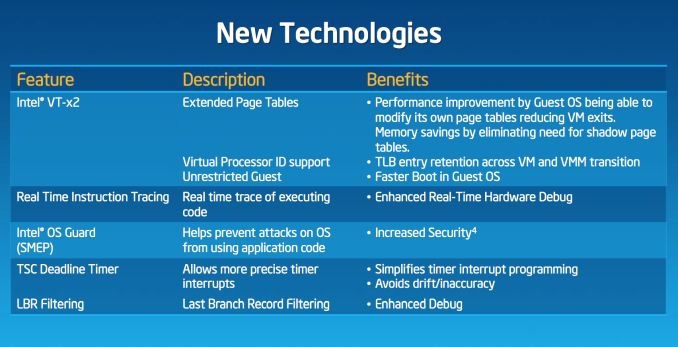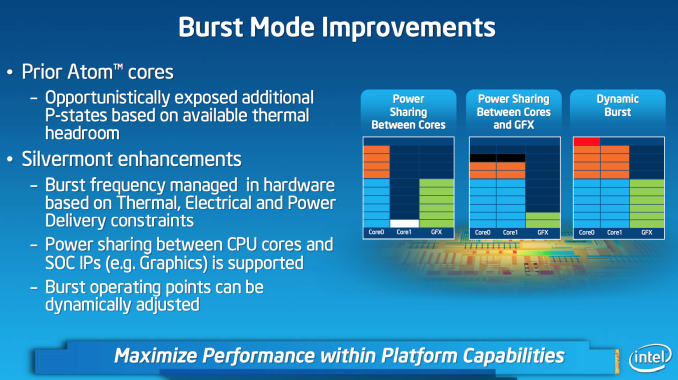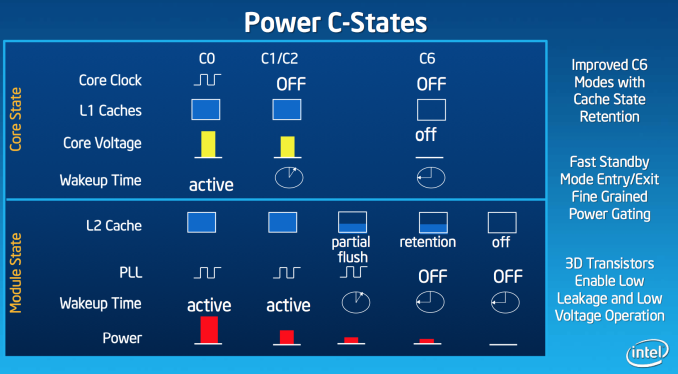Intel’s Silvermont Architecture Revealed: Getting Serious About Mobile
by Anand Lal Shimpi on May 6, 2013 1:00 PM EST- Posted in
- CPUs
- Intel
- Silvermont
- SoCs
ISA
The original Atom processor enabled support for Merom/Conroe-class x86 instructions, it lacked SSE4 support due to die/power constraints; that was at 45nm, at 22nm there’s room for improvement. Silvermont brings ISA compatibility up to Westmere levels (Intel’s 2010 Core microprocessor architecture). There’s now support for SSE4.1, SSE4.2, POPCNT and AES-NI.
Silvermont is 64-bit capable, although it is up to Intel to enable 64-bit support on various SKUs similar to what we’ve seen with Atom thus far.
IPC and Frequency
The combination of everything Intel is doing on the IPC front give it, according to Intel, roughly the same single threaded performance as ARM’s Cortex A15. We’ve already established that the Cortex A15 is quite good, but here’s where Silvermont has a chance to pull ahead. We already established that Intel’s 22nm process can give it anywhere from a 18 - 37% performance uplift at the same power consumption. IPC scaling gives Silvermont stable footing, but the ability to run at considerably higher frequencies without drawing more power is what puts it over the top.
Intel isn’t talking about frequencies at this point, but I’ve heard numbers around 2 - 2.4GHz thrown around a lot. Compared to the 1.6 - 2GHz range we currently have with Bonnell based silicon, you can see how the performance story gets serious quickly. Intel is talking about a 50% improvement in IPC at the core, combine that with a 30% improvement in frequency without any power impact and you’re now at 83% better performance potentially with no power penalty. There are other advantages at the SoC level that once factored in drive things even further.
Real Turbo Modes & Power Management
Previous Atom based mobile SoCs had a very crude version of Intel’s Turbo Boost. The CPU would expose all of its available P-states to the OS and as it became thermally limited, Intel would clamp the max P-state it would expose to the OS. Everything was OS-driven and previous designs weren’t able to capitalize on unused thermal budget elsewhere in the SoC to drive up frequency in active parts of chip. This lack of flexibility even impacted the SoC at the CPU core level. When running a single threaded app, Medfield/Clover Trail/et al couldn’t take thermal budget freed up by the idle core and use it to drive the frequency of the active core. Previous Atom implementations were basically somewhere in the pre-Nehalem era of thermal/boost management. From what I’ve seen, this is also how a lot of the present day ARM architectures work as well. At best, they vary what operating states they expose to the OS and clamp max frequency depending on thermals. To the best of my knowledge, none of the SoC vendors today actively implement modern big-core-Intel-like frequency management. Silvermont fixes this.
Silvermont, like Nehalem and the architectures that followed, gets its own power control unit that monitors thermals and handles dynamic allocation of power budget to various blocks within the SoC. If I understand this correctly, Silvermont should expose a maximum base frequency to the OS but depending on instruction mix and available TDP it can turbo up beyond that maximum frequency as long as it doesn’t exceed TDP. Like Sandy Bridge, Silvermont will even be able to exceed TDP for a short period of time if the package temperature is low enough to allow it. Finally, Silvermont’s turbo can also work across IP blocks: power budget allocated to the GPU can be transferred to the CPU cores (and vice versa).
By big-core standards (especially compared to Haswell), Silvermont’s turbo isn’t all that impressive but compared to how things are currently handled in the mobile space this should be a huge step forward.
On the power management side, getting in and out of C6 should be a bit quicker. There's also a new C6 mode with cache state retention.















174 Comments
View All Comments
t.s. - Tuesday, May 7, 2013 - link
If Intel play fair few years back, maybe now we have competitive offerings from AMD. That practice Intel's doing hurt AMD alot. Until now.Homeles - Monday, May 6, 2013 - link
I'm sure Anand would be drawing plenty of comparisons if he had a Temash tablet in hand.Bob Todd - Monday, May 6, 2013 - link
As an owner of two Bobcat systems (laptop/mini-itx), I don't think a 25% boost from Jaguar is going to get us into the realm of "good enough" cpu performance for general computing in Windows. The same goes for Intel unless Silvermont is significantly faster than Jaguar. I'm excited that Intel is finally bringing something interesting to the table, even if we end up two to three generations away from a good experience in Windows with their (and AMD's) mobile offerings. This sounds like it will make for a beastly dual core Android phone though, even at lower clocks.jjj - Monday, May 6, 2013 - link
Hilarious difference in attitude when it comes to Intel.Tegra 4 gets into phones by "aggressively limiting frequency." while Intel " Max clock speeds should be lower than what’s possible in a tablet, but not by all that much thanks to good power management. "
Objectivity at it's best.
Homeles - Monday, May 6, 2013 - link
Your scenario is a false equivalency.Krysto - Monday, May 6, 2013 - link
Is it? I wouldn't accuse Anand of "objectivity" when it comes to Intel, whether it's on purpose, or involuntary.nunomoreira10 - Monday, May 6, 2013 - link
The point is tegra 4 was not exactly made for phones while Intel was, for that you have tegra4iits not exacly nvidia fault, everybody complained that tegra 3 was lacking, now tegra 4 which is competitive consumes to much, atleast there is a choice.
Homeles - Monday, May 6, 2013 - link
A15s are big cores in relation to its relatives. The only way to fit not 2, not 4, but *5* of them in a phone on 28nm is to downclock them agressively. Just like the only way to fit Ivy Bridge in a tablet is to downclock it agressively.Anand did point out that the "the only A15 SoCs we've seen have been very leaky designs optimized for high frequency," and that if power consumption were prioritized instead (which I believe Tegra 4i is supposed to be), it would be less of a blowout.
It's silly getting defensive about stock ARM cores anyways. It's not an attack on Nvidia by saying their stock ARM cores aren't all too spectacular -- it's not like they poured blood, sweat and tears into making their A15s the best thing ever.
Finally, Tegra 4 is on a process that is rather significantly inferior to Intel's 22nm process. You think Nvidia would have to downclock agressively if they were on a level playing field and using Intel's 22nm process? I sure don't. But jjj and others here feel the need to get defensive whenever songs of praise are being sung about Intel, even when it's well deserved.
extide - Tuesday, May 7, 2013 - link
I am in agreeance with what you said, but I do believe Tegra 4i is Cortex A9, not A15 like Tegra 4.Wilco1 - Tuesday, May 7, 2013 - link
The Korean Galaxy S4 has a 1.8GHz Exynos Octa, Tegra 4 does 1.9GHz. In what way are these "aggressively downclocked"? They run at their maximum frequency!